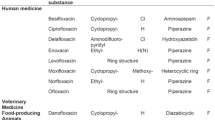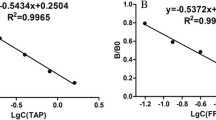Abstract
The abuse of antibiotics, such as the cephalosporins in livestock and aquaculture productions, usually causes the widespread antibiotic resistance due to their growth-promoting effects. In this study, cephalexin was chosen as the hapten molecule to prepare a broad-spectrum rabbit polyclonal antibody for cephalosporin antibiotics. The obtained antibody exhibited broad cross-reactivity ranging from 0.05% to 100% with 10 cephalosporins. Based on this antibody, we developed a broad-specific indirect competitive ELISA (ic-ELISA) for cefalexin, cefradine, cefadroxil and cefazolin with the half maximal inhibitory concentration (IC50) ranging from 0.72 to 2.99 ng/mL in working buffer. For animal-derived food samples with spiked cephalosporins, the ic-ELISA exhibited an excellent recovery ranging from 72.3% to 95.6%. To verify the accuracy of this proposed ic-ELISA, its detection performance was evaluated utilizing the high-performance liquid chromatography with satisfactory results. This study confirmed that: firstly, the prepared antibody can be used as a class-specific recognition element to develop immunoassays for cephalosporin antibiotics; and secondly, the developed ic-ELISA provided a new tool for broad-spectrum detection of first-generation cephalosporins in animal-derived foods.


Similar content being viewed by others
References
Adegoke OA, Quadri MO (2016) Novel spectrophotometric determinations of some cephalosporins following azo dye formation with p-dimethylaminobenzaldehyde. Arab J Chem 9(2):S1272–S1282
Bacanli M, Başaran N (2019) Importance of antibiotic residues in animal food. Food Chem Toxicol 125:462–466
Ben Y, Fu C, Hu M, Liu L, Wong M, Zheng C (2019) Human health risk assessment of antibiotic resistance associated with antibiotic residues in the environment: a review. Environ Res 169:483–493
Bora I, Demir AB, Uzun P (2016) Nonconvulsive status epilepticus cases arising in connection with cephalosporins. Epilepsy Behav Case Rep 6:23–27
Bremus A, Dietrich R, Dettmar L, Usleber E, Märtlbauer E (2012) A broadly applicable approach to prepare monoclonal anti-cephalosporin antibodies for immunochemical residue determination in milk. Anal Bioanal Chem 403(2):503–515
Chen L, Wang Z, Ferreri M (2009) Cephalexin residue detection in milk and beef by ELISA and colloidal gold based one-step strip assay. Agric Food Chem 57:4674–4679
Chen X, Ye E (2016) Graphene oxide-reinforced hollow fiber solid-phase microextraction coupled with high-performance liquid chromatography for the determination of cephalosporins in milk samples. Food Anal Methods 9:2452–2462
Chen T, Cheng G, Ahmed S, Wang Y, Wang X, Hao H, Yuan Z (2017) New methodologies in screening of antibiotic residues in animal-derived foods: biosensors. Talanta 175:435–442
Dillon PP, Daly SJ, Browne JG, Manning BM, Loomans E, Amerongen AV, O’Kennedy R (2003) Application of an immunosensor for the detection of the β-Lactam antibiotic, cephalexin. Food Agric Immunol 15:225–234
Fan Q, Wang X, Zhou Q et al (2010) Synthesis of artificial antigens of diethylstilbestrol and preparation of its antibody. Front Agric China 4(2):188–194
Karageorgou EG, Samanidou VF (2010) Application of ultrasound-assisted matrix solid-phase dispersion extraction to the HPLC confirmatory determination of cephalosporin residues in milk. J Sep Sci 33(17/18):2862–2871
Liu Q, Xu L, Ke Y, ** Y, Zhang F, Liang X (2011) Analysis of cephalosporins by hydrophilic interaction chromatography. J Pharm Biomed Anal 54(3):623–628
Li W, Shen H, Hong Y, Zhang Y, Yuan F, Zhang F (2016) Simultaneous determination of 22 cephalosporins drug residues in pork muscle using liquid chromatography–tandem mass spectrometry. J Chromatogr B 1022:298–307
Lu P, Yang S, Hu D, Ding X, Shi M (2013) Synthesis of hapten and development of immunoassay based on monoclonal antibody for the detection of dufulin in agricultural samples. J Agric Food Chem 61(43):10302–10309
Martínez-Rodríguez JE, Barriga FJ, Santamaria J, Iranzo A, Pareja JA, Revilla M, Rosa CR (2001) Nonconvulsive status epilepticus associated with cephalosporins in patients with renal failure. Am J Med 111(2):115–119
Menkem ZE, Ngangom BL, Tamunjoh SSA, Boyom FF (2018) Antibiotic residues in food animals: public health concern. Acta Ecol Sin 39(5):411–415
Primavera A, Cocito L, Audenino D (2004) Nonconvulsive status epilepticus during cephalosporin therapy. Neuropsychobiology 49:218–222
Strasser A, Usleber E, Schneider E et al (2003) Improved enzyme immunoassay for group-specific determination of penicillins in milk. Food Agric Immunol 15(2):135–143
Wang S, Xu B, Zhang Y, He J (2009) Development of enzyme-linked immunosorbent assay (ELISA) for the detection of neomycin residues in pig muscle, chicken muscle, egg, fish, milk and kidney. Meat Sci 82:53–58
Wang Q, Zhao W (2018) Optical methods of antibiotic residues detections: a comprehensive review. Sens Actuators B 269:238–256
Zhang F, Liu B, Sheng W, Zhang Y, Liu Q, Li S, Wang S (2018) Fluoroimmunoassays for the detection of zearalenone in maize using CdTe/CdS/ZnS quantum dots. Food Chem 255:421–428
Zhi ZL, Meyer UJ, Van den Bedem JW et al (2001) Evaluation of an automated and integrated flow-through immunoanalysis system for the rapid determination of cephalexin in raw milk. Anal Chim Acta 442(2):207–219
Acknowledgements
This work was financially supported by Hebei Provincial Science and Technology Department “Study on High-throughput Rapid Immunoassay Technology for Cephalosporins in Animal-derived Foods” (No. 17275502D).
Author information
Authors and Affiliations
Corresponding author
Additional information
Publisher's Note
Springer Nature remains neutral with regard to jurisdictional claims in published maps and institutional affiliations.
Rights and permissions
About this article
Cite this article
Liu, M., Sang, Y., Zhang, J. et al. Development of a Broad-Specific Competitive ELISA for First-Generation Cephalosporin Antibiotics in Animal-Derived Foods Samples. Bull Environ Contam Toxicol 107, 215–220 (2021). https://doi.org/10.1007/s00128-020-02885-y
Received:
Accepted:
Published:
Issue Date:
DOI: https://doi.org/10.1007/s00128-020-02885-y




